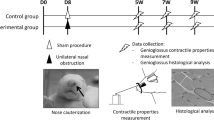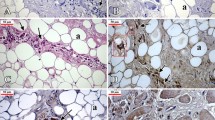Abstract
We examined changes in the expressions of three atrophy-related transcription factors (FOXO3a, P-FOXO3a, and PGC-1α) in the process of intrinsic laryngeal muscle atrophy after denervation. In total, 51 Wistar rats were used. After transection of the unilateral recurrent laryngeal nerve, the thyroarytenoid (TA) muscle and the posterior cricoarytenoid (PCA) muscle were excised and subjected to histological and Western blot studies. Relationships between the expressions of transcription factors during atrophy of the intrinsic laryngeal muscles were investigated by comparing the results of the treated side (T) with those of the untreated side (U), and sequential changes in the T/U ratio after denervation were assessed. Loss of wet muscle weight, together with a decrease in muscle fiber cross-sectional area and increase in the number of muscle fibers/mm2, occurred more quickly in TA muscle than in PCA muscle. Muscle atrophy progressed rapidly between 7 and 28 days after denervation, while expression of FOXO3a was maximal on day 7, in both TA and PCA muscles. By contrast, P-FOXO3a expression decreased gradually after denervation. Expression of PGC-1α increased slowly until day 7, and then it declined. Denervation-induced atrophy of the intrinsic laryngeal muscles was closely linked with the expression of FOXO3a and PGC-1α, suggesting that atrophy of these muscles may involve the actions of these transcription factors. In addition, muscle atrophy progressed faster in TA muscle than in PCA muscle, due mainly to differences in muscle fiber composition.



Similar content being viewed by others
References
Okamoto T, Torii S, Machida S (2011) Differential gene expression of muscle-specific ubiquitin ligase MAFbx/Atrogin-1 and MuRF1 in response to immobilization-induced atrophy of slow-twitch and fast-twitch muscles. J Physiol Sci 61:537–546. doi:10.1007/s12576-011-0175-6
Stitt TN, Drujan D, Clarke BA, Panaro F, Timofeyva Y, Kline WO, Gonzalez M, Yancopoulos GD, Glass DJ (2004) The IGF-1/PI3K/Akt pathway prevents expression of muscle atrophy-induced ubiquitin ligases by inhibiting FOXO transcription factors. Mol Cell 14:395–403
Sandri M, Sandri C, Gilbert A, Skurk C, Calabria E, Picard A, Walsh K, Schiaffino S, Lecker SH, Goldberg AL (2004) Foxo transcription factors induce the atrophy-related ubiquitin ligase atrogin-1 and cause skeletal muscle atrophy. Cell 117:399–412
Bertaggia E, Coletto L, Sandri M (2012) Posttranslational modifications control FoxO3 activity during denervation. Am J Physiol Cell Physiol 302:C587–C596. doi:10.1152/ajpcell.00142.2011
Shiotani A, Flint W (1998) Myosin heavy chain composition in rat laryngeal muscles after denervation. Laryngoscope 108:1225–1229
Nishida N, Taguchi A, Motoyoshi K, Hyodo M, Gyo K, Desaki J (2013) Age-related changes in rat intrinsic laryngeal muscles: analysis of muscle fibers, muscle fiber proteins, and subneural apparatuses. Eur Arch Otorhinolaryngol 270:975–984. doi:10.1007/s00405-012-2231-0
Files DC, Xiao K, Zhang T, Liu C, Qian J, Zhao W, Morris PE, Delbono O, Feng X (2014) The posterior cricoarytenoid muscle is spared from MuRF1-mediated muscle atrophy in mice with acute lung injury. PLoS ONE 31(9):e87587. doi:10.1371/journal.pone.0087587
Feng X, Zhang T, Ralston E, Ludlow CL (2012) Differences in neuromuscular junctions of laryngeal and limb muscles in rats. Laryngoscope 122:1093–1098. doi:10.1002/lary.23218
Donghui C, Shicai C, Wei W, Fei L, Jianjun J, Gang C, Hongliang Z (2010) Functional modulation of satellite cells in long-term denervated human laryngeal muscle. Laryngoscope 120:353–358. doi:10.1002/lary.20796
Sacheck JM, Hyatt JK, Raffaello A, Jagoe RT, Roy RR, Edgerton VR, Lecker SH, Goldberg AL (2007) Rapid disuse and denervation atrophy involve transcriptional changes similar to those of muscle wasting during systemic diseases. FASEB J 21:140–155
Goldspink DF (1976) The effects of denervation on protein turnover of rat skeletal muscle. Biochem J 15(156):71–80
Wei B, Dui W, Liu D, Xing Y, Yuan Z, Ji G (2013) MST1, a key player, in enhancing fast skeletal muscle atrophy. BMC Biol 1(11):12. doi:10.1186/1741-7007-11-12
Sandri M, Lin J, Handschin C, Yang W, Arany ZP, Lecker SH, Goldberg AL, Spiegelman BM (2006) PGC-1alpha protects skeletal muscle from atrophy by suppressing FoxO3 action and atrophy-specific gene transcription. Proc Natl Acad Sci USA 103:16260–16265
Brault JJ, Jespersen JG, Goldberg AL (2010) Peroxisome proliferator-activated receptor γ coactivator 1α or 1β overexpression inhibits muscle protein degradation, induction of ubiquitin ligases, and disuse atrophy. J Biol Chem 285(25):19460–19471. doi:10.1074/jbc.M110.113092
Conflict of interest
The authors disclose no financial or other conflict of interest. The authors are solely responsible for the content and writing of the paper.
Author information
Authors and Affiliations
Corresponding author
Rights and permissions
About this article
Cite this article
Sei, H., Taguchi, A., Nishida, N. et al. Expression of atrophy-related transcription factors in the process of intrinsic laryngeal muscle atrophy after denervation. Eur Arch Otorhinolaryngol 272, 137–141 (2015). https://doi.org/10.1007/s00405-014-3226-9
Received:
Accepted:
Published:
Issue Date:
DOI: https://doi.org/10.1007/s00405-014-3226-9




